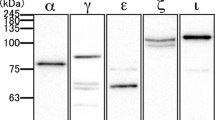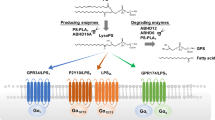Abstract
We have previously reported that ACTH activates a phospholipase C that hydrolyzes glycosylphosphatidylinositol (GPI), which would release inositolphosphoglycan (IPG) to the extracellular medium, and that an IPG purified from Trypanosoma cruzi is able to inhibit ACTH-mediated steroid production in adrenocortical cells. In the present paper, it was found that anti-inositolphosphoglycan antibodies (anti-CRD) increased ACTH-mediated corticosterone production, which indicates that an endogenous IPG is a physiological inhibitor of ACTH response. On the other hand, we investigated the release to the extracellular medium of the GPI-anchored enzyme, alkaline phosphatase, by ACTH. We found that: (a) the released enzyme appeared in the aqueous phase after Triton X-114 partitioning, consistent with loss of the GPI, (b) the phospholipase C inhibitor, U73122, impaired the release of the enzyme by the hormone and (c) two inhibitors of IPG uptake, inositol 2-monophosphate and 2 M NaCl, increased the amount of alkaline phosphatase in the extracellular medium. These results suggest that ACTH releases alkaline phosphatase by activation of a phospholipase C. Dibutyryladenosine-3′,5′-cyclic monophosphate (db-cAMP) was able to increase the release of alkaline phosphatase from adrenocortical cells and this effect was inhibited by U73122, suggesting that cAMP is involved in the activation of phospholipase C. In addition, it was found that a pertussis-toxin sensitive G-protein is required for ACTH- and db-cAMP-mediated release of alkaline phosphatase and that incorporation of anti-Gi antibodies in adrenocortical cells inhibited the release of alkaline phosphatase by ACTH. Our results suggest that ACTH increases the release of alkaline phosphatase by activation of a phospholipase C through cAMP and Gi which would contribute to produce IPG. It was also found that the two inhibitors of IPG uptake, inositol-2-monophosphate and 2 M NaCl, increased the amount of alkaline phosphatase in the extracellular medium of ACTH-treated cells more than in control cells, indicating that ACTH also stimulates the uptake of IPG. These data support a role of GPI and the involvement of Gi in ACTH action.
Similar content being viewed by others
References
LeHoux JG, Bernard H, Ducharme L, Lefebvre A, Shapcott D, Tremblay A, Veronneau S: In: C.R. Jefcoate (ed). Advances in Molecular and Cell Biology, vol. 14. J.A.I. Press, London, 1996, pp 149–201
Bird I, Walker S, Williams B: Agonist-stimulated turnover of the phosphoinositides and the regulation of adrenocortical steroidogenesis. J Mol Endocrinol 5: 191–209, 1990
Vilgrain I, Cochet C, Chambaz E: Hormonal regulation of a calcium-activated, phospholipid-dependent protein kinase in bovine adrenal cortex. J Biol Chem 259: 3403–3406, 1984
Papadopoulos V, Brown A, Hall P: Calcium-calmodulin-dependent phosphorylation of cytoskeletal proteins from adrenal cells. Mol Cell Endocrinol 74: 109–123, 1990
Gallo-Payet N, Cote M, Chorvatova A, Guillon G, Payet M: Cyclic AMP-independent effects of ACTH on glomerulosa cells of the rat adrenal cortex. J Steroid Biochem Mol Biol 69: 335–342, 1999
Stevens V: Biosynthesis of glycosylphosphatidylinositol membrane anchors. Biochem J 310: 361–370, 1995
Ferguson M: The structure, biosynthesis and function of glycosyl-phosphatidylinositol anchors, and the contributions of Trypanosome research. J Cell Sci 112: 2799–2809, 1999
Singh N, Liang L, Tykocinscki M, Tartakoff A: A novel class of cell surface glycolipids of mammalian cells. J Biol Chem 271: 12879–12884, 1996
Jones D, Varela-Nieto I: The role of glycosyl-phosphatidylinositol in signal transduction. Int J Biochem Cell Biol 30: 313–326, 1998
Saltiel A: The paradoxical regulation of protein phosphorylation in insulin action. FASEB J 8: 1034–1040, 1994
Susuki S, Taneda Y, Hirai S, Satoh Y, Toyota T: Insulin stimulates hydrolysis of plasmanylinositol-glycan and phosphatidylinositol-glycan in rat adipocytes. Insulin-induced generation of inositol glycan, alkylacylglycerol and diacylglycerol. Diabetes 42: 988–994, 1993
Cozza E, Vila M, Gomez-Sanchez C, Farese R: ACTH stimulates turnover of the phosphatidylinositol-glycan. Biochem Biophys Res Commun 157: 585–589, 1988
Bogdanowicz P, Pujol J: Glycosylphosphatidylinositol (GPI) hydrolysis by transforming growth factor-beta1 (TGF-beta1) as a potential early step in the inhibition of epithelial cell proliferation. Mol Cell Biochem 208: 143–150, 2000
Romero G, Gamez G, Huang L, Lilley K, Luttrell L: Anti-inositolglycan antibodies selectively block some of the actions of insulin in intact BC3 H1 cells. Proc Natl Acad Sci USA 87: 1476–1480, 1990
Deeg M, Brass E, Rosenberry T: Inositolglycan phosphate derived from human erythrocyte acetylcholinesterase glycolipid anchor and inositol cyclic 1,2-phosphate antagonize glucagon activation of glycogen phosphorylase. Diabetes 42: 1318–1323, 1993
Frick W, Bauer A, Bauer J, Wied S, Müller G: Insulin-mimetic signalling of synthetic phosphoinositolglycans in isolated rat adipocytes. Biochem J 336: 163–181, 1998
Vila M, Milligan G, Standaert M, Farese R: Insulin activates glycerol-3-phosphate acyltransferase (de novo phosphatidic acid synthesis) through a phospholipid-derived mediator. Apparent involvement of Gi and activation of a phospholipase C. Biochemistry 29: 8735–8740, 1990
Vila M, Farese R: Insulin rapidly increases glycerol-3-phosphate acyltransferase activity in rat adipocytes. Arch Biochem Biophys 284: 366–368, 1991
Müller G, Wied S, Crecelius A, Kessler A, Eckel J: Phosphoinositolglycan-peptides from yeast potently induce metabolic actions in isolated rat adipocytes, cardiomyocytes, and diaphragms. Endocrinology 138: 3459–3475, 1997
Luttrell L, Hewlett E, Romero G, Rogol A: Pertussis toxin treatment attenuates some effects of insulin in BC3H-1 murine myocytes. J Biol Chem 263: 6134–6141, 1988
Movahedi S, Hooper N: Insulin stimulates the release of the glycosyl phosphatidylinositol-anchored membrane dipeptidase from 3T3-L1 adipocytes through the action of a phospholipase C. Biochem J 326: 531–537, 1997
Alvarez J, Sanchez-Arias J, Guadaño A, Estevez F, Varela I, Feliu J, Mato J: Transport in isolated rat hepatocytes of the phospho-oligosaccharide that mimics insulin action. Effects of adrenalectomy and glucocorticoid treatment. Biochem J 274: 369–374, 1991
Müller G, Wetekam E, Jung C, Bandlow W: Membrane association of lipoprotein lipase and a cAMP-binding ectoprotein in rat adipocytes. Biochemistry 33: 12149–12159, 1994
Igarashi Y, Chambaz E: A novel inositolglycophospholipid and the serum dependence of its metabolism in bovine adrenocortical cells. Biochem Biophys Res Commun 145: 249–256, 1987
Lederkremer R, Lima C, Ramirez M, Casal O: Structural features of lipopeptidophosphoglycan from Trypanosoma cruzi common with glycophosphatidylinositol anchors. Eur J Biochem 192: 337–345, 1990
Lederkremer R, Lima C, Ramirez M, Ferguson M, Homans S, Thomas-Oates J: Complete structure of the glycan of lipopeptidophosphoglycan from Trypanosoma cruzi epimastigotes. J Biol Chem 266: 23670–23675, 1991
Vila M, Cozza E, Ramirez M, Lima C, Lederkremer R: An inositol phosphoglycan from Trypanosoma cruzi inhibits ACTH action in calf adrenocortical cells. Cell Signal 7: 331–339, 1995
Avalos S, Lima C, Martini C, Lederkremer R, Vila M: ACTH-mediated glucocorticoid and mineralocorticoid production is inhibited by an inositolphosphoglycan and a glycosylphosphatidylinositol-phospholipase C is activated by the hormone in mammalian adrenocortical cells. Steroids 63: 70–75, 1998
Saltiel A: Insulin generates an enzyme modulator from hepatic plasma membranes: Regulation of adenosine3′,5′-monophosphate phosphodiesterase, pyruvate dehydrogenase and adenylate cyclase. Endocrinology 120: 967–972, 1987
Villalba M, Kelly K, Mato J: Inhibition of cyclic AMP-dependent protein kinase by the polar head group of an insulin-sensitive glycophospholipid. Biochim Biophys Acta 968: 69–76, 1988
Gomez-Sanchez C, Murry B, Kem D, Kaplan N: A direct radioimmunoassay of serum corticosterone in the rat. Endocrinology 96: 796–798, 1975
Bordier C: Phase separation of integral membrane proteins in Triton X-114 solution. J Biol Chem 256: 1604–1607, 1981
Bradford M: A rapid and sensitive method for the quantitation of microgram quantities of protein utilizing the principle of protein-dye binding. Analytical Biochem 72: 248–254, 1976
Laemmli U: Cleavage of structural proteins during the assembly of the head of bacteriophage T4. Nature 227: 680–685, 1979
Sakata N, Stoops J, Dixon J: Cytosolic components are required for proteasomal degradation of newly synthesized apolipoprotein B in permeabilized HepG2 cells. J Biol Chem 274: 17068–17074, 1999
Zamze S, Ferguson M, Collins R, Dwek R, Rademacher T: Characterization of the cross-reacting determinant (CRD) of the glycosyl-phosphatidylinositol membrane anchor of Trypanosoma brucei variant surface glycoprotein. Eur J Biochem 176: 527–534, 1988
Butikofer P, Boschung M, Brodbeck U, Menon A: Phosphatidylinositol hydrolysis by Trypanosoma brucei glycosylphosphatidylinositol phospholipase C. J Biol Chem 271: 15533–15541, 1996
Boudot C, Kadri Z, Petitfrere E, Lambert E, Chretien S, Mayeux P, Haye B, Billat C: Phosphatidylinositol 3-kinase regulates glycosylphosphatidylinositol hydrolysis through PLC-gamma(2) activation in erythropoietin-stimulated cells. Cell Signal 14: 869–878, 2002
Yule D, Williams J: U 73122 inhibits Ca2+ oscillations in response to cholecystokinin and carbachol but not to JMV-180 in rat pancreatic acinar cells. J Biol Chem 267: 13830–13835, 1992
Waldron R, Rozengurt E: Oxidative stress induces protein kinase D activation in intact cells. Involvement of Src and dependence on protein kinase C. J Biol Chem 275: 17114–17121, 2000
Roberts J, Kenton P, Jhonson P: Growth factor-induced release of a glycosyl-phosphatidylinositol(GPI)-linked protein from HEp-2 human carcinoma cell line. FEBS Lett 267: 213–216, 1990
Müller G, Hanekop N, Kramer W, Bandlow W, Frick W: Interaction of phosphoinositolglycan(-peptides) with plasma membranes lipid rafts of rat adipocytes. Arch Biochem Biophys 408: 17–32, 2002
Saltiel A, Sorbara-Cazan L: Inositol glycan mimics the action of insulin on glucose utilization in rat adipocytes. Biochem Biophys Res Commun 149: 1084–1092, 1987
McKenzie F, Kelly E, Unson C, Spiegel A, Milligan G: Antibodies which recognize the C-terminus of the inhibitory guanine-nucleotide-binding-protein (Gi) demonstrate that opioid peptides and foetal-calf serum stimulate the high-affinity GTPase activity of two separate pertussis-toxin substrates. Biochem J 249: 653–659, 1988
Strassheim D, Milligan G, Houslay M: Diabetes abolish the GTP-dependent but not the receptor-dependent inhibitory function of the inhibitory guanine-nucleotide-binding regulatory protein (Gi) on adipocyte adenylate cyclase activity. Biochem J 266: 521–526, 1990
Park S, Choi K, Kim I, Lee H, Hooper N, Park H: Endogenous glycosylphosphatidylinositol-specific phospholipase C releases renal dipeptidase from kidney proximal tubules in vitro. Biochem J 353: 339–344, 2001
Han M, Yim C, An N, Kim H, Kim U: Glycosylphosphatidylinositol-anchored NAD glycohydrolase is released from peritoneal macrophages activated by interferon-gamma and lipopolysaccharide. J Leukoc Biol 56: 792–796, 1994
Miscia S, Di Baldassarre A, Cataldi A, Rana RA, Di Valerio V, Sabatino G: Novel evidence of expression and activity of ecto-phospholipase C gamma1 in human T lymphocytes. Blood 91: 3833–3840, 1998
Romero G, Luttrell L, Rogol A, Zeller K, Hewlett E, Larner J: Phosphatidylinositol-glycan anchors of membrane proteins: Potential precursors of insulin mediators. Science 240: 509–511, 1988
Cote M, Guillon G, Payet M, Gallo-Payet N: Expression and regulation of adenylyl cyclase isoforms in the human adrenal gland. J Clin Endocrinol Metabolism 86: 4495–4503, 2001
Daaka Y, Luttrell L, Lefkowitz, L: Switching of the coupling of the β2-adrenergic receptor to different G-proteins by protein Kinase A. Nature 390: 88–91, 1997
Soeder K, Snedden S, Cao W, Della-Roca G, Daniel K, Luttrell L, Collins S: The β3-adrenergic receptor activates mitogen-activated protein kinase in adipocytes through a Gi-dependent mechanism. J Biol Chem 274: 12017–12022, 1999
Luo X, Zeng W, Xu X, Popov S, Davignon I, Wilkie T, Mumby S, Muallem S: Alternate coupling of receptors to Gs and Gi in pancreatic and submandibular gland cells. J Biol Chem 274: 17684–17690, 1999
Author information
Authors and Affiliations
Rights and permissions
About this article
Cite this article
Martini, C.N., Vaena de Avalos, S.G. & del Carmen Vila, M. ACTH stimulates the release of alkaline phosphatase through Gi-mediated activation of a phospholipase C and the release of inositolphosphoglycan. Mol Cell Biochem 258, 191–199 (2004). https://doi.org/10.1023/B:MCBI.0000012855.94291.dd
Issue Date:
DOI: https://doi.org/10.1023/B:MCBI.0000012855.94291.dd




